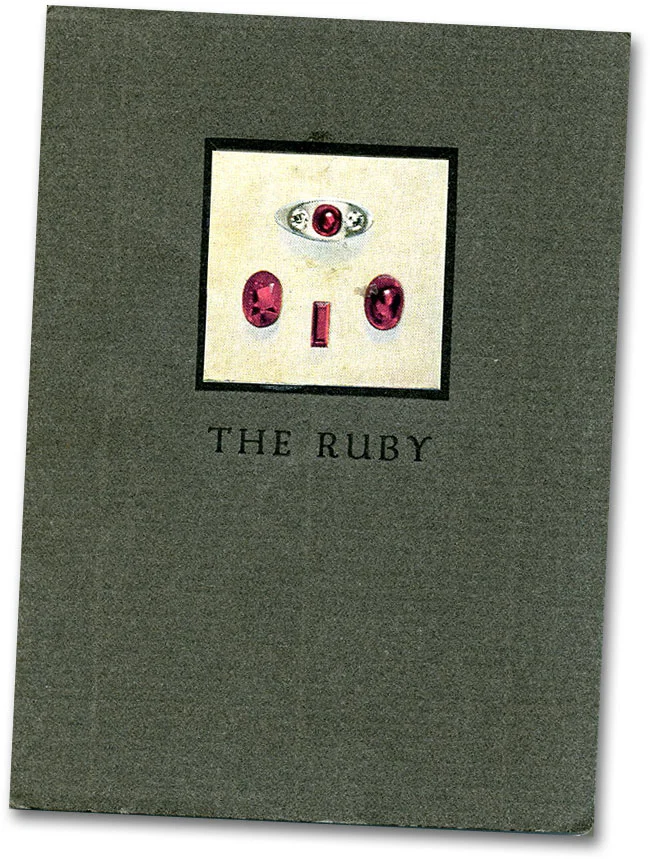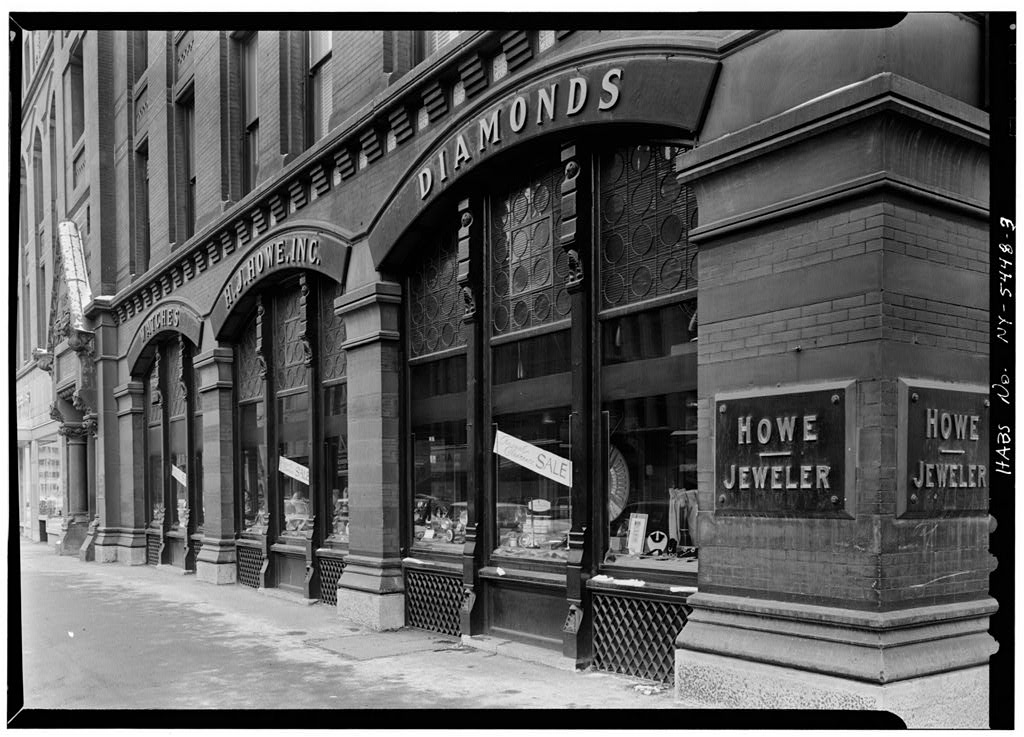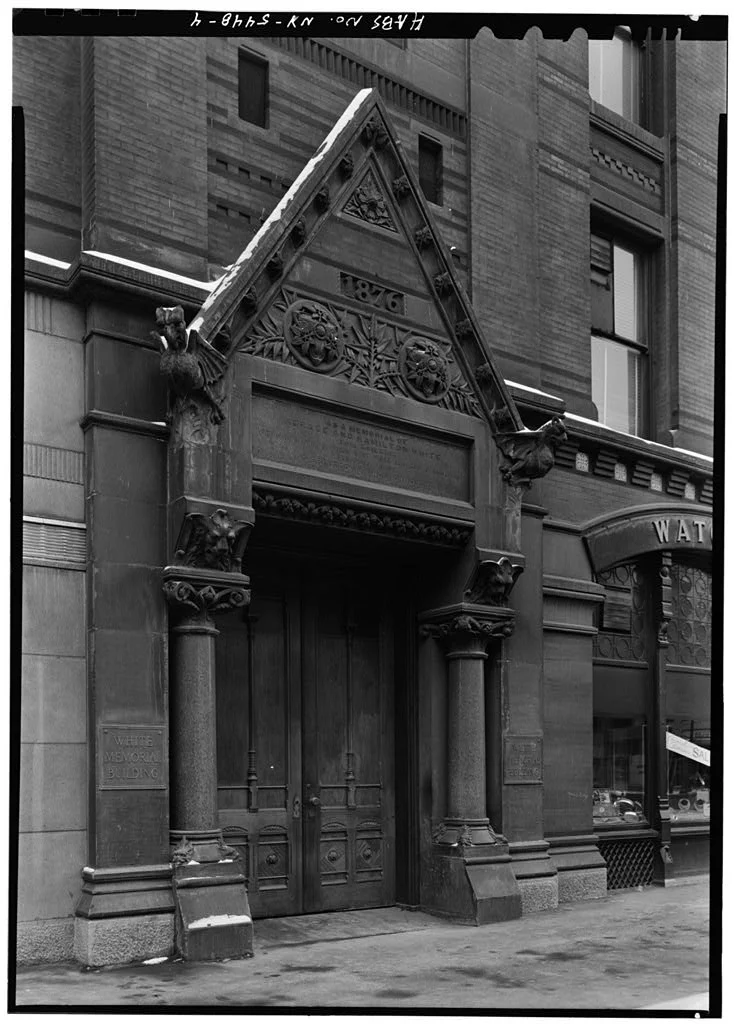The Ruby
The Ruby
Published by H. J. Howe, Jeweler
Syracuse, New York
Following is the text of a promotional booklet of fourteen pages published in about 1924 by H(enry) J. Howe, a jewelry firm located from 1860 to 1978 in Syracuse, New York. The text is attributed to Justin Wood. J. R. Wood & Son was itself a New York City jewelry firm established in 1850, with locations in Chicago and San Francisco as well as a production plant in Brooklyn.
Foreword
It is hard for us to imagine the vast accumulations of gems that are to be found in some of the State Treasuries of the Orient.
Great fortunes in gems could be hoarded within small compass and easily moved in times of danger. These were the Oriental potentate's security against the tottering of his throne.
Of the gems in these collections the warmblooded ruby, more often mentioned in Hindu legend than any other, has always been a favorite.
The inventory of the jewel-treasuries of the late Shah of Persia, shows their value to be about fifty million dollars. Among the gems are many priceless rubies, one of them (set in the Royal Crown}, is as large as a hen's egg.
THE RUBY
Birthstone for July
Symbol of Courage
The blood-red ruby, its glowing color aptly suggesting the heat of midsummer, is one of the rarest and most beautiful gems. While since the earliest times many different stones, including the various kinds of garnet, red tourmaline and others, have been erroneously called rubies, the true or "Oriental" ruby is a distinct species, composed like the lovely sapphire, of corundum. Corundum, the name of which is derived from an old Hindu word, first came from India. It is a crystallized form of aluminum and ranks next to the diamond in hardness. A less valuable form of this material than the gem ruby or sapphire is frequently encountered in the polishing-wheels and other abrasive implements that are used in machine-shops.
Nearly all of the finest rubies are procured from Burma where the ruby mines have been known and operated for many centuries. These mines are worked upon concessions purchased from the Burmese Crown, but the purchaser of such a concession is allowed to retain only stones under a certain size, all larger gems becoming the property of the Crown. For this reason but few fine rubies of great size have found their way outside of Burma, and it is to be deplored that many small and unimportant gems which find their way into the European markets were once a part of fine large stones which were broken into fragments by their finders to prevent their confiscation by the Crown.
One of the King of Burma's titles is "Lord of the Rubies." It is, therefore natural that he should be the possessor of the finest known collection of these gems.
The finding of a ruby of great size and beauty is a cause for celebration in Burma, it being the custom to send out a procession of grandees, soldiers and elephants in ceremonial attire to escort the gem into the royal city.
Good rubies of a slightly darker color than the Burmese stones are found in quantity in Siam. Inferior gems are procured from Ceylon and India, while occasionally the ruby is encountered in North Carolina and Montana.
Detail from the cover of The Ruby. It is the only illustration contained in the booklet.
Quality in the Ruby
The finest ruby is the one which in point of color most closely approximates the fresh blood of a pigeon and which is comparatively free from flaws or inclosures of foreign substances.
The common faults of inferior specimens are lack of clearness, the presence of clouds, cracks and fissures, uneven distribution of color, paleness or too great depth of color.
Value
So valuable are flawless rubies of good color that when they ascend above a carat in weight their values depend to a considerable extent upon fancy. A three carat ruby of desirable qualities is a rarity and possesses a value many times greater than that of a diamond of the same size.
For almost a hundred years, H. J. Howe, Inc. was in the White Memorial Building at South Salina and East Washington Streets in Syracuse. These photographs were taken by Jack Boucher, January 1962, as part of the Historic American Buildings Survey conducted by the National Park Service. (Source: Library of Congress)
History
Throughout history the ruby has held equal place with the emerald in value among gems. It was known to the ancient Greeks as "anthrax," to the Romans as "carbunculus". It was one of the twelve stones used in the Ephod or sacred breastplate of the Jewish High Priest. It is interesting to note that according to the Arab historian Abd-er-Rhaman, writing 829 A.D., the sarcophagus of Cheops, the Pharaoh of the Great Pyramid, contained a sword which bore in its hilt a fine ruby "as large, as a hen's egg and brilliant as a flame."
Tradition
As the ancients believed the ruby to be of a phosphoric nature, becoming more radiant if exposed to heat or to the full rays of the sun, it was made the subject of much tradition. Thus, according to the Talmud, Abraham, when keeping his wives shut up in an iron city, in order to give them light set a bowl of rubies in the center of the city, which filled all the air with lustre.
In ancient and medieval times the ruby was thought to possess the quality of warning its wearer of the presence of poison by growing dark and cloudy. By the same manifestations it was believed to indicate evil, misfortune, or any danger which threatened its owner. The following, taken from a sixteenth century work on gems, explains one way at least in which such a belief could have gained foothold:
A wealthy jeweler one day having washed his hands, sat at a table, when, glancing at a ruby ring he wore on his finger, he noticed that the stone which usually delighted his eye had lost its brilliancy and become dull. Since he believed in the superstitions connected with the gem, he became convinced that some misfortune threatened him, so he removed the ring and placed it in a case. A fortnight later one of this man's sons died. Reminded by this event of the phenomenon observed in the ruby, the jeweler took it from its case and found that it had recovered its pristine brilliancy. This fact confirmed him in his belief in the ominous quality of the stone. Once more, shortly after washing his hands he remarked anew that the splendor of the ruby was dimmed, and again fell a prey to anxiety, lest some fresh misfortune was impending. Since, however, his apprehensions proved vain and no untoward event occurred, he investigated the matter carefully, and discovered that the obscuration of the color was due to a drop of water which had penetrated between the ruby and a foil that was placed beneath the stone to improve its color. When the water evaporated the former brilliancy of the stone returned.
The ruby was regarded as a potent charm against sadness and many forms of sin and vice. If the four corners of a house, garden or vineyard were touched with a ruby, they would be preserved from lightning, tempests and worms.
A belief is held by the Burmese that rubies ripen in color gradually while maturing in the earth-like fruit upon a sunny wall. This idea seems to have prevailed also among the writers of the fifteenth and sixteenth centuries.
Entrance to the jewelry store, in the midst of its annual post-holiday clearance sale.
A Strange Belief
The Burmese believe that the ruby confers invulnerability. To attain this end, however, it is not thought to be sufficient to wear the stone set in a ring, but the gem must be inserted in the flesh and thus become, in a way, a part of the owner's body. Those who in this way bear about with them a ruby, confidently believe that they cannot be wounded by spear, sword or gun. A somewhat similar idea prevails among the Hindus who believe that the possessor of a fine ruby may live in peace and concord in the midst of his enemies. The power of this protection is supposed to depend upon the degree of perfection of the stone.
The ruby was used extensively as a cure for the plague, hemorrhages, and to dispell pestilential vapors. It was also used in the treatment of diseases of the eyes and for disordered livers.
Famous Rubies
Because of the fact that the largest rubies found in Burma are hoarded by the Burmese sovereigns, fine gems of great size have seldom found their way into Europe. There are, notwithstanding, a few noteworthy specimens.
Perhaps the finest ruby is the gem known by the formidable name, "Gnaga Boh;" Dragon Lord. This stone weighed forty-four carats in the rough, twenty carats after cutting. It is absolutely perfect.
The largest ruby of which we have record was a stone which weighed four hundred carats in the rough. This gem was broken into three parts of which two were cut, resulting in fine gems weighing seventy and forty-five carats.
A ruby the size of a pigeon's egg, once in the Russian regalia, was presented to the Czarina Catherine by Gustave III of Sweden, in 1777. This is the largest ruby in Europe.
When Peter the Great went to England in 1697, (working as a shipwright in the dockyards at Deptford), he paid a visit to William III, whom he had met before at the Hague. In taking his final leave Peter fumbled for a moment in his waistcoat pocket and drew therefrom a small parcel wrapped in a shabby scrap of dirty brown paper. This he pressed into the hand of King William. It contained a ruby worth fifty thousand dollars.
The great gem set in the Maltese cross fronting the Imperial Crown of England was for many years believed to be a priceless ruby. It is, however, a spinel—a stone of no great value.
The entrance to the White Memorial Building, with its famous gargoyles.
Synthetic Rubies
It seems not amiss, inasmuch as we have heard a great deal about synthetic rubies in recent years. to add a word concerning these stones.
The term "synthetic" must not be confused with the word "imitation," for while a ruby's appearance can be imitated in glass, such a fabrication will not stand the tests that are used to distinguish the true ruby. The synthetic gem, on the other hand, is in structure a true ruby which will stand all tests of hardness, specific gravity, etc., though artificially produced. Such gems are easily distinguished from natural rubies by those who are familiar with them. Their production has tended to increase the value of true gems rather than to diminish it.
The fine pigeon-blood ruby is more rarely encountered in modern jewelry than any other gem, not because it is lacking in popularity but because of the ever-increasing difficulty with which good specimens are obtained. During the past few years the demand for the ruby has steadily increased and jewelers have had no difficulty in finding a ready market for such gems as they have been able to obtain. Those who possess good rubies are fortunate, for with the increasing demand there has been a commensurate increase in their value.
Full view of the White Memorial Building at South Salina and East Washington Streets, January 1962.
The building as it appeared in January 2008. (Photo: Lvklock via Wikipedia)
For the information contained in this little book, we are indebted to the following authors, to whom we wish to extend our thanks:
Mr. Julius Wodiska
Dr. George Frederick Kunz
Dr. W. T. Fernie
Mr. C. W. King
Mr. Frank B. Wade
Mr. G. F. Herbert Smith
Mr. W. R. Cattelle







